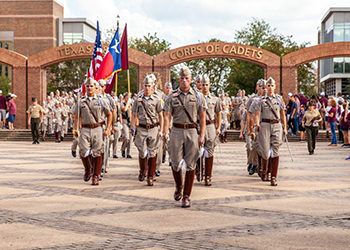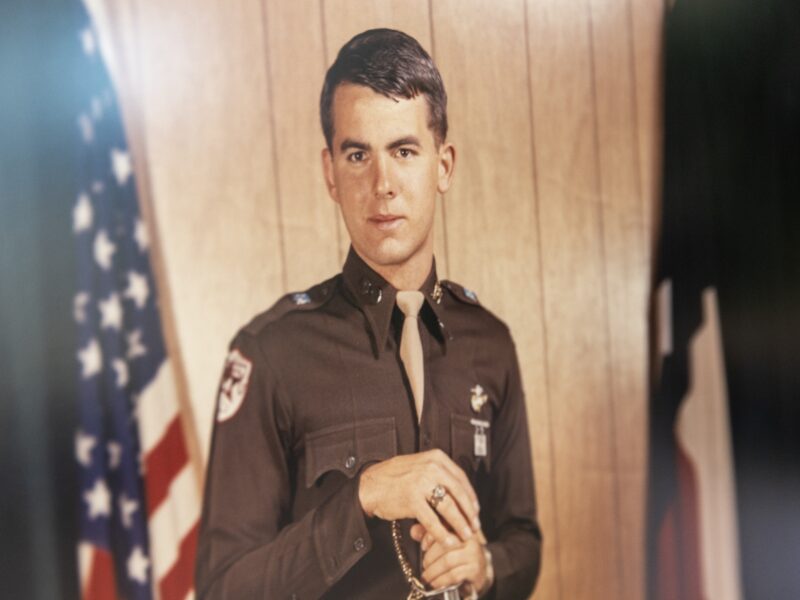Corps Of Cadets Growing, Largest Freshman Class In Quarter-Century

More young men and women are choosing to be in the Texas A&M University Corps of Cadets this fall than at any time in the past 14 years, with current strength standing at 2,128. This is largely attributable to the largest freshman class since 1987.
All indications point to the Texas A&M Corps continuing to be the largest uniformed group on any campus and in good position to continue to consistently produce more officers for the armed forces than any institution in the nation, except for, in both categories, the service academies, Corps officials note.
With Army, Air Force, and Navy/Marine ROTC instruction available, Texas A&M is one of the few schools to offer military commissions in all branches of service. A total of 179 cadets were commissioned into one of the branches during the 2010-2011 school year, including 33 more at the end of the summer session in August, 2011. That’s despite the datum that the Department of Defense is allowing fewer young men and women to have opportunities to receive commissions, a result of national budgetary constraints and other considerations.
The fact is that most members of the Corps of Cadets choose to be in the all-volunteer organization because of the camaraderie and leadership opportunities that will serve them well, notes Brig. Gen. Joe E. Ramirez, Jr. (US Army-Ret.), a 1979 Texas A&M graduate who returned to his alma mater this year to serve as commandant of the Corps of Cadets.
“For 135 years, the Texas A&M University Corps of Cadets has built a solid, leadership foundation first for young men, and then young women as well, to transition into their professional lives,” continues Gen. Ramirez. “It is no longer only military commissions that the Corps supports, but also those who wish to seek careers in the public and private sectors. The Corps of Cadets provides a balanced and structured lifestyle that helps them achieve academic excellence and gives cadets the opportunity to master management and organizational skills and become leaders — now and throughout their lives and professional endeavors.”

Gen. Ramirez has made academic excellence, recruiting and retention and diversity his top priorities.
“Academic excellence is strongly emphasized as a member of the Corps of Cadets,” explains Gen. Ramirez. “The main reason these cadets are at Texas A&M is for a college education. As a member of the Corps, they have opportunities to work within their outfits and with the Office of the Commandant’s staff to best achieve their academic success. With mandatory study time, access to tutors and access to many academic advisors, a cadet has many advantages a regular student does not. It has to be a priority for all of us, and we stress that the cadets can achieve academic success within the structure of the Corps.”
A major factor in the increased size of the Corps this year is the number of freshmen—fish, as they are called — who signed on this fall: 822, including 107 women, the most fish since 1987 and 77 more than 2010. The current overall Corps strength stands at 2,128, which is 180 more than last year, including 238 women.
Increasing the numbers in the Corps of Cadets is not as easy as it may appear, the general emphasizes.
“One aspect that certainly narrows our field of play is the rigorous admission standards set by Texas A&M,” clarifies Gen. Ramirez. “We have so many kids each year that would love nothing more than to be in the Corps of Cadets, but they simply do not have the test scores, grades, or involvement in extracurricular activities to get into Texas A&M. It’s frustrating for them, but we certainly understand that Texas A&M is one of the best universities in the nation, and must set stringent admissions standards. If a prospective student cannot get into A&M, they cannot join the Corps. There is a misperception out there that there is a way to join the Corps regardless of the admissions process, but there is not. To become a member of the Corps, you must be accepted as a student at Texas A&M.
The Aggie Corps recruiting program is quite complex. Long gone are the days when most anyone interested could just come to Texas A&M and become a member of the Corps. High school college fairs are frequent areas of interest for a number of our former students or other interested parties. These “Aggie Corps recruiters” work around the state and surrounding areas in conjunction with Corps Recruiting in identifying and working with prospective cadets. The cadets themselves have a recruiting company that contacts and corresponds with prospective students as well as leads and mentors them at various events on campus like “Spend the Night with the Corps“.
“We have a hard-working recruiting department whose only goal is to get young men and women into the Corps,” says Gen. Ramirez, “but as the old saying goes, ‘it takes a village’, we certainly couldn’t do it alone. That personal connection from former students, outside recruiters and especially our cadet recruiting chain makes all the difference in the world.”
As with any organization, retention is always a challenge. “The Corps is a very rigorous lifestyle and many find it too challenging to adapt to the structured lifestyle,” explains Gen. Ramirez. “So, throughout the year and the Corps strength fluctuates, but we are focused on increasing retention, inducting new cadets to the lifestyle in a positive and productive way and retaining as many of them as we can. “We are already seeing positive results from our efforts.”
The current fish retention rate as of the end of September is 91% (9% attrition) compared to 88% retention (12% attrition) same time last year, Six outfits in the Corps still currently have 100% fish retention.
Diversity is another priority for the Corps of Cadets as it is with Texas A&M as a whole.
“The Corps has made some progress in the area of diversity over the past 10-20 years, but it is an area that still needs work in my opinion,” says Gen. Ramirez. “I want the Corps to reflect today’s society. We’re not there yet, but our continued recruiting outreach and regional programs, and working alongside the University and their diversity efforts should begin to reap its rewards in the near future.”
The Corps of Cadets has a storied past, a dynamic present and a promising future, the general notes. With a targeted Corps strength of 2,600 by 2015, there is much more hard work to be done, but the path has been set and the Corps of Cadets is marching onward, he concludes.
For more information about the Corps of Cadets, go to corps.tamu.edu or call 800-TAMU-AGS.
Media contact: tamunews@tamu.edu.





